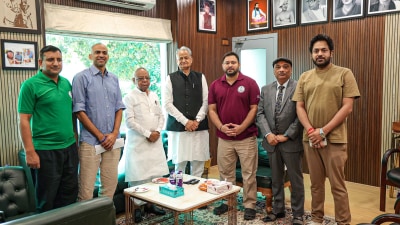Yusuf Arakkal: The One Who Feared No Struggle
Artist Yusuf Arakkal, who passed away on Tuesday, always wanted to give back. If his salute to the fraternity was through sketches, his depictions of the urban poor won him numerous awards. Friends remember his unfailing empathy.
 The dark background in several of Yusuf Arakkal’s works are considered to be inspired by Dutch artist Rembrandt.
The dark background in several of Yusuf Arakkal’s works are considered to be inspired by Dutch artist Rembrandt.
Born into the Arakkal royal family of Kerala, he spent his childhood dreaming of life as an artist. To fulfil that desire, Yusuf Arakkal fled home. At 16, with Rs 15 and a copy of Charles Dickens’s A Tale of Two Cities, he boarded a train to Bengaluru — the city where he also breathed his last on October 4. He was unwell for the last couple of months. The 71-year-old seminal artist is survived by his wife Sara and son, photographer Shibu Arakkal.
“He was very vocal about his accomplishments, also because of all that he had achieved on his own. He never feared struggle and wanted to give back and do his bit for society and the art fraternity,” says artist Gita Hudson, who curated the recently concluded exhibition of Arakkal’s works at Dakshinachitra, Chennai, and also made a documentary on him titled Quest in Solitude.
Unlike his usual works that reflect social issues and human predicament, the series titled “Faces of Creativity” featured portraits of over 100 artists sketched by Arakkal, including Amrita Sher-Gil, Jamini Roy, MF Husain and Ramkinkar Baij. “In a way, this was his tribute to the art fraternity,” says Hudson.
Born in Chavakkad, Thrissur, Kerala, Arakkal lost his parents at a young age. During his initial years in Bengaluru, he reportedly fended for himself, doing odd jobs as a construction labourer and automobile mechanics assistant. Later, the football aficionado joined the Hindustan Aeronautics Limited. “My struggle on the streets was the best university I ever attended. That equipped me for the future struggle in art,” he said, in an interview to The Indian Express in 2007.
Before he completed a diploma in painting from the Karnataka Chitrakala Parishath in Bengaluru in 1973, Arakkal had received training in portraiture from Jaya Varma, grand nephew of Raja Ravi Varma. While his early abstracts depicted the lives of city dwellers, he moved to more figurative depictions later and also dabbled with different mediums, including sculpture and graphics. Christ and Krishna were recurring subjects in his work. His Pipes and Pavements series won him the National Award in 1983. The dark background in several of his works are considered to be inspired by Dutch artist Rembrandt. He also turned to Pablo Piccaso’s famous work Guernica (which depicts the Nazi bombing of Guernica, a town in northern Spain), when he painted the 2002 Gujarat riots.
The recipient of the 2013 Raja Ravi Varma Puraskaram, Arakkal often supported and promoted young talent through Galerie Sara Arakkal in Bengaluru, which he established with his wife in 2003. “He was very magnanimous, and often helped young artists,” says artist Achuthan Kudallur, a close associate of Arakkal. While several books have been written on him and his work — including The Street: Arakkal Paints a Picture, a photographic book by Nemai Ghosh — Arakkal also published some of his poems and narrated his experiences of travelling in Kerala, which includes his paintings and drawings in In Touch with My Roots: A Creative Journey Through Kerala (Penguin, Rs 1, 250).
“For some years he had been working on a book on nude art, with his own work and referencing the works of some other artists. It will perhaps come out posthumously,” says Hudson.





- 01
- 02
- 03
- 04
- 05






















